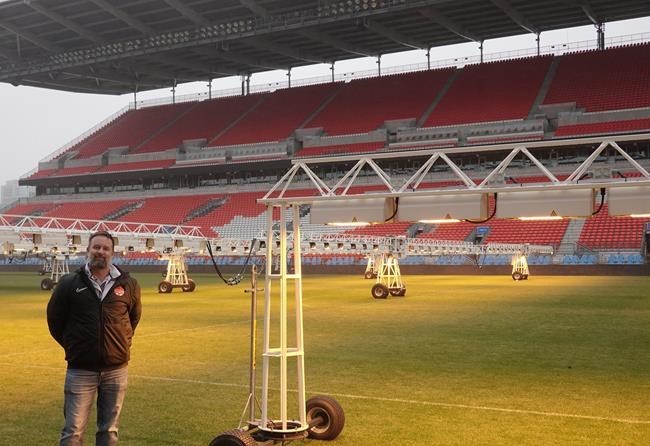TORONTO — A new era dawns Saturday at Toronto FC's home opener. With Michael Bradley retired, there will be no pre-match pitch inspection by the TFC captain — unless new skipper Jonathan Osorio continues the tradition.
It's a pity because Bradley, who used to check the playing surface like clockwork, probably would have liked what he saw.
"He was very particular," Robert Heggie, director of grounds at MLSE, said with a belly laugh. "That was his job. He was the captain.
"But we had a great relationship," he added. "And he did drive us to get some of our tools that we have out there. And he drove us to be the perfectionists that we are today as well."
A mild winter, coupled with a well-armed groundskeeping crew, has the hybrid grass at BMO Field looking good.
"It's one of the better home opener fields it's had," said Heggie. "But it's not July. It's not August … It looks great for March 9."
You don't have to be agronomist to see that, given the state of grass everywhere else in the city.
"I'd say the grass probably thinks it's April 1st instead of March 1st," said Heggie.
His job is all about fooling the grass to think it is a little later than the calendar says. But as Heggie knows, you can only deceive Mother Nature so much.
And winter may not be done.
After the Argonauts were beaten 38-17 by Montreal in the Nov. 11 CFL Eastern final, Heggie and his crew went to work on the pitch, removing the organic "gunk" that accumulates over time in the hybrid grass surface.
The process, using special machine, helps bring the artificial fibres intertwined with the real grass "back to life (and) back to the surface" so it can do what it is supposed to do.
"At the end of the year we probably removed 20 per cent of the field," said Heggie.
They opted not to cover it initially. The fear was a huge snowfall, coupled with a covered pitch, could lead to disease due to moisture buildup.
But come January, with temperatures mild, the cover went on.
"We knew that the plant was going to be happy," said Heggie. "It was in a better place."
The cover came off recently and grow-lights were deployed.
Toronto (1-0-1) will test out the playing surface at training Friday ahead of the visit by Charlotte FC (1-0-1).
Saturday's forecast calls for 6 C and rain, as opposed to last year's opener when close to 10 centimetres of snow fell the day before, meaning the grounds crew was at work before 6 a.m. game day to shovel, mow, paint and prepare.
"Running your tractor across the field with a shovel on game day is not what any groundskeeper wants to do," Heggie lamented. "But the show must go on, as they say.
"So that day it looked great. But really we could see the damage from that into Game 2 and Game 3."
It was -2 C at kickoff, said to feel like -7, as Toronto drew 1-1 with Columbus.
Heggie proudly notes BMO Field ticks every FIFA box when it comes to playing surface and groundskeeping bells and whistles. With the World Cup coming, that's good to hear.
"Heggie is already looking ahead to 2026 with mock-ups of what the shadows will look like in the stadium once the south and north ends get the additional seating planned for the tournament.
On Wednesday, as drizzle fell, the field looked surprisingly good. There was some evidence of poa, an invasive grass easy to spot because of its different colour.
"It's good but March 9, to get it that consistent (colour), I'd have to be fooling it (the grass) into June or July," said Heggie. "And then that come with a lot of risk if you get snow."
While the stadium has underground heating, it isn't used for chunks of the winter. It's better to let the grass freeze because snow mould isn't a factor below a certain temperature.
"If you let if freeze, all the disease pressure actually goes away,' he said. "It's when it's under the snow and it's warm under here, that's when it really starts to incubate the disease."
The rain forecast for Saturday is not a problem given the field "is built to drain."
"This is my 15th home opener. We don't get good weather for the first (game)," Heggie said with a laugh.
Heggie says the team prefers the grass to be between an inch and three-quarters of an inch for ball speed, which is FIFA's recommended height of cut.
"Most teams I've dealt with want it fast. The faster the better."
—
Follow @NeilMDavidson on X platform, formerly known as Twitter
This report by The Canadian Press was first published March 7, 2024.
Neil Davidson, The Canadian Press



